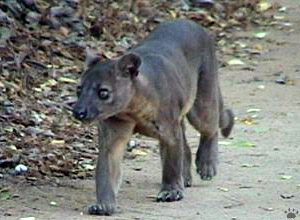
Fossa (Cryptoprocta ferox), Kirindi Nature Reserve, Madagascar.
Madagascar - Part 4
The arrival of humans has led to extinction of almost all large animals on Madagascar: giant lemurs, three species of hippos, four species of world's largest birds (Aepyornis), and a weird anteater-like creature called Bibymalagasy have all disappeared before European contact. Humans also introduced all the usual invasive species: feral dogs and cats, roof rats and house mice, plus African bush pigs, Asian house shrews, and Indian civets.
 |
 |
 |
| Fossa, Kirindi Nature Reserve. |

Fossa, Kirindi NR. |
The largest surviving native mammal is fossa. It is a secretive forest predator, but sometimes occurs in more open landscapes and steals chickens from villages. It is very strong for its size, and such a good climber that it can chase lemurs in the canopy. At 8-12 kg, it is a bit too small to be dangerous for humans, but locals think otherwise, and tell all the same stories about fossa as people in other places tell about wolves. I've heard people warning their kids not to go too far from the house, "or fossa will eat you". Some even claim that fossa can kill cows. For scientists, fossa is a bit of a mystery, too. It has been considered an aberrant cat, a giant mongoose, or a civet. It has retractable claws like a cat, walks on the soles of its feet like a wolverine, looks a bit like a jaguarundi, and has scent glands like a mongoose. Fossa is very difficult to see: many naturalists who have lived and worked on Madagascar for decades have never seen it. Well, fellow trackers, am I good or what? |

Fossa, Kirindi NR. |
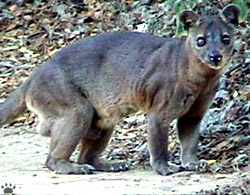
Fossa, Kirindi NR. |
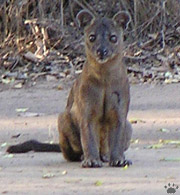
Fossa, Kirindi NR. |
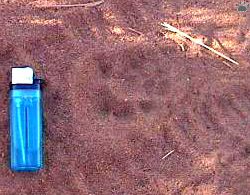
Fossa track on a road, Parc National d'Ankarafantsika. |
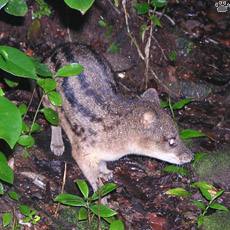
Malagasy civet (Fossa fossana),
Parc National Ranomafana. |
Smaller native carnivores include two species of civets and 4-6 species of mongooses. The civets are nocturnal and seldom seen, while mongooses are diurnal and very common in some Nature reserves. They move through the forest in small groups, searching through leaf litter in search of small prey. When in a group, they carry their tails high, apparently to make it easier to others to stay together. All species sometimes visit garbage dumps at the edge of the forest.
|
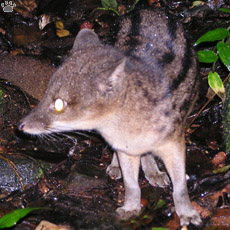
Malagasy civet (Fossa fossana),
Parc National Ranomafana. |
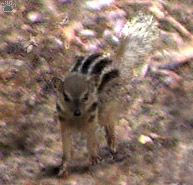
Broad-striped mongoose (Galidia fasciata),
Parc National Marojejy. |
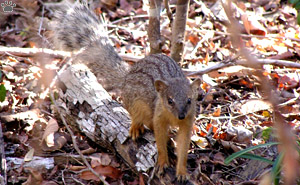
Narrow-striped mongoose (G. decimlineata), Kirindi Nature Reserve. |
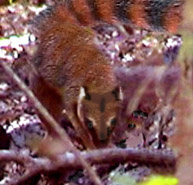
Band-tailed mongoose (G. elegans),
Parc National L'Ankarana. |
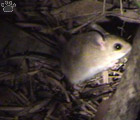
Macrotarsomys bastardi,
Kirindi FR. |
Madagascar has 17 endemic species of rodents, ranging in size from tiny Macrotarsomys mice to giant Hypogeomys rats. |
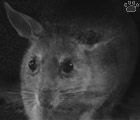
Hypogeomys antimena,
Kirindi FR. |
Most of them live in forests, and can be easy to find by spotlighting, especially in relatively open dry forests of the west. |
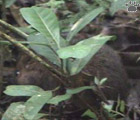
Nesomys rufus,
PN Ranomafana. |

Eilodon deppeanum and Rousettus madagascarensis
fruit bats, L'Ankarana. |
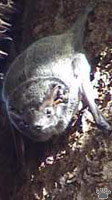
Emballonura atrata,
PN L'Ankarafantsika. |

Eilodon deppeanum and Rousettus madagascarensis
fruit bats, L'Ankarana. |
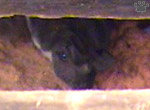
Mops condylurus bat, L'Isalo
National Park, Madagascar. |
Madagascar has at least 27 species of bats. Numerous caves in areas of limestone karst, locally known as tsingy, shelter huge colonies of fruit, tomb, horseshoe-nosed, slit-faced and vespertilionid bats. Large colonies of freetail bats often occur in buildings, while sheathtail bats and flying foxes roost in trees. The most interesting one is tiny, big-eared bat called Myzopoda aurita - the sole member of an endemic family. |
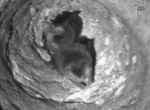
Bats Pipistrellus nanus are
only 4 cm long. L'Ankarana. |

Common tenrec (Tenrec eucaudatus),
PN Marojejy. |
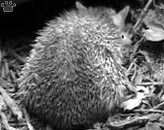
Greater hedgehog tenrec (Setifer
setosus), PN L'Ankarana. |
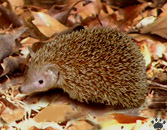
Lesser hedgehog tenrec (Echinops
telfari), Morondava. |
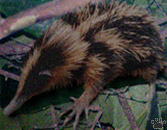
Striped tenrec (Hemicenter
semispinosus), PN Masoala. |

Long-tailed shrew
tenrec (Microgale
longicauda),
Moromandia. |
The most ancient mammals of Madagascar are 23 species of tenrecs. The larger four look more or less like agile, social hedgehogs. The smaller ones look like shrews, and one rare species is aquatic. The only tenrecs outside Madagascar are two species of otter shrews from Africa. Tenrecs inhabit all island, but are more numerous and diverse in the forests. Small ones apparently hibernate in areas with cold winter nights. Interestingly, one species of true shrews also occurs naturally on Madagascar. |

Long-eared shrew
tenrec (Geogale
aurita), PN
d'Ankarafantsika. |

Habitat of web-footed tenrec (Limnogale mergulus), Parc National Masoala. |
Part 5: Birds
Back to Part 3
Home
|